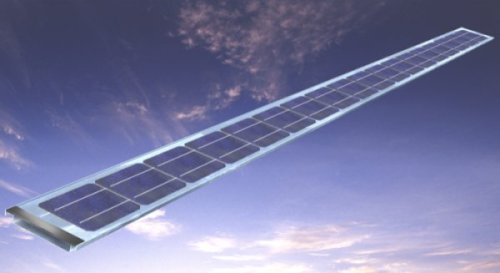The Linear Module


Solar Automation is introducing a simple and revolutionary new way to manufacture PV modules. We took a long look at the process, materials and design of today’s modules and systematically questioned every premise. The objective was to cut the cost of PV modules while assuring quality to last 30 years. We discovered an unexpected benefit: the PV module factory became dramatically simpler and less expensive to set up.
When cars were born a hundred years ago they were made in garages. As the need for lower costs drove the industry toward automation, the automobile changed. Today's car bodies are specifically designed to be welded by robots. Henry's Model T could not be automated; it had to be redesigned first.
The first commercial photovoltaic solar panels were made in a garage as well. Some of today's solar panels or PV modules are made by robots, but the design never really changed. They got bigger and better but the garage design remains. This has made it very difficult and therefore expensive for anyone to make a fully automated PV module.
Design-for-Automation, DfA, is an old and proven technique for converting a product to the highest level of manufacturability, that is, full automation. First, every piece of the product is scrutinized for function, necessity and cost. Similarly, one looks at every process used to make each part. Following that, assembly processes are reviewed. Each step in this technique is driven to eliminate parts or processes. Instead of looking for better ways, the engineer looks for things to eliminate, without compromising quality, of course.
Once the product passes the above review, the remaining assemblage is analyzed anew for changes and opportunities that will further simplify the materials and processes needed. Then, combining functions, using one part to eliminate three, requires some imagination, but further reduces the part count.
We applied the principles of DfA to the venerable PV module and the results were far-reaching. The module becomes a linear device like a fluorescent light fixture. The expensive aluminum extruded frame goes away and is replaced by a roll-formed, sheet metal, multi-functional backbone. The same backbone eliminates the Tedlar® or glass back-sheet. The turn-around circuiting and the associated processes are all gone. We added a terminal bar at each end to establish a reliable external electrical connect-disconnect. The J-box is gone.
Something else happens when you do such a redesign. All the robots that did all those eliminated processes are no longer required. Not only have we eliminated unnecessary product cost, we have reduced immensely the cost and complexity of the whole factory. When you simplify your factory, you also reduce the huge cost of maintaining complex capital equipment.
Now that we have reduced the direct cost per watt, the capital outlay for equipment, and the cost of operation and maintenance, we have created a new kind of product with new kinds of applications. We visualize linear modules as an exciting new option for BIPV (building integrated photovoltaics), on telephone poles, and as a roof-top tracker.
![]()
[ Home ] [ Soldering Equipment ] [ Parts and Service ] [ The Linear Module ] [ The Roof-Top Tracker ] [ The MicroFactory ] [ About Solar Auto ] [ Contact ]
Copyright Solar Automation, Inc. 2007